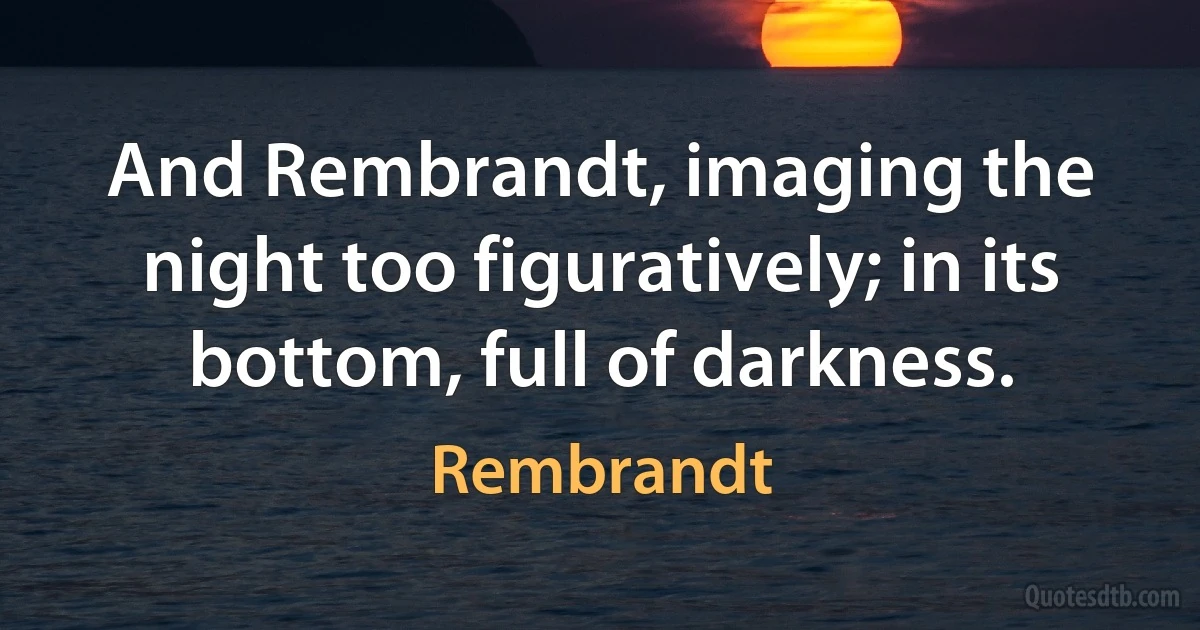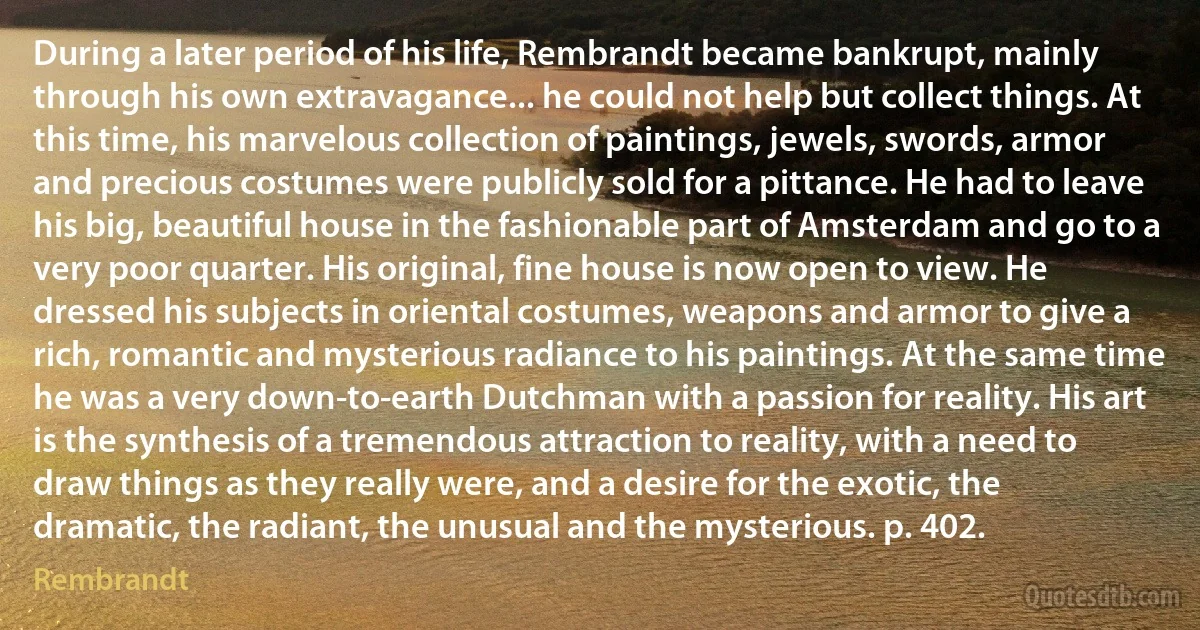Rembrandt quotes - page 3
With regard to art he [Rembrandt] was rich with ideas, so that you frequently see him making a great number of different sketches of one and the same object, full also of changes in the figures and poses as well as the arrangement of the clothing; for which he is to be praised above all others – especially above those who employ such figures and clothing in their work as if they were twins.

Rembrandt
I am very sure that if Rembrandt had held himself down to his studio practice (drawing every figure nude before putting clothing on them) he would not have either that power of pantomime nor that power over effects which makes his scenes so genuinely the expression of nature.. ..the further I go on in life the more I feel within me that truth is what is most beautiful, and most rare.. ..[this] is to be found again in Rembrandt's mysterious conception of his subjects, in the deep naturalness of expressions and of gestures.

Rembrandt
A painting by Rembrandt not only stops the time that made the subject flow into the future, but makes it flow back to the remotest ages. By means of this operation Rembrandt achieves solemnity. He thus discovers why, at every moment, every event is solemn: he knows it from his own solitude.

Rembrandt
Rembrandt was already deeply involved in his attachment to Rubens - at once adopting him as his model and fighting to have the differences noticed. His [painting] 'Descent from the Cross', also painted in 1631 for the Stadholder, was directly taken from the engraving after Rubens's greatest masterpiece in Antwerp Cathedral', while at the same time being a calculated Protestant response to the immense diapason of the [catholic] Flemish master's altar-piece.

Rembrandt
The picture of Jan Six, painted in 1654 is, then, a virtual encyclopedia of painting, from the loosest handling to the dry brush, sparely loaded with yellow, dragged over the surface at the edge of Six's right cuff; from the finest detail to the most impressionist daring. Yet Rembrandt manages to bring all this diversity of technique into a totally resolved single image. So that Jan Six does indeed stand before us much as we would dearly wish to imagine ourselves, all the contradictions of our character-vanity and modesty, outward show and inward reflectiveness, energy and calm-miraculously fitted together.

Rembrandt
Two aphorisms about Rembrandt's paintings were drawn from his early biographies and repeatedly attributed to the artist by the French writers: 'A painting is finished when the artists says that it is finished' and 'A painting is not made to be sniffed', but contemplated from a distance.. .These paintings were identified with the latter years of Rembrandt's life, the period in which critics said he suffered most from financial pressures and a lack of public acclaim. Works identified with these final years were the most popular in France during the last decades of the nineteenth century.

Rembrandt
Alongside Leonardo and Michelangelo, Rembrandt is one of the three most famous artists ever, with whom the public is on a first-name basis; and the name Rembrandt has lent the cachet of greatness and the grace of familiarity to sell everything from kitchen countertops to whitening toothpaste to fancy hotels in Bangkok and Knightsbridge. No work of Rembrandt's has attained the iconic status of the David or the Mona Lisa; yet Rembrandt seems to rank with the greatest of the great.

Rembrandt
Kolakowski, as we will see, has clearly depicted the religious life and the forms of community constructed by the cultured strata of the Dutch bourgeoisie. Spinoza lives in this world, with a vast network of simple and sociable friendships and correspondences. But for certain determinate strata of the bourgeoisie the sweetness of the cultured and sedate life is accompanied, without any contradiction, by an association with a capitalist Power ('potestas'), expressed in very mature terms. This is the condition of a Dutch bourgeois man. We could say the same thing for the other genius of that age, Rembrandt van Rijn. On his canvases the power of light is concentrated with intensity on the figures of a bourgeois world in terrific expansion. It is a prosaic but very powerful society, which makes poetry without knowing it because it has the force to do so.

Rembrandt
In The Night Watch, again in Amsterdam, we have the feeling of communication: that something dramatic is happening before our very eyes. This scene of a company of guards painted as a group portrait was very popular in Rembrandt's day. The only other Dutch painter who could do anything at all with the subject was Frans Hals, who did it several times and rather well. But the conventions prevailing at the time were for such a group portrait to consist of an inert line of figures which was boring in the extreme. Rembrandt, tackling this subject, sees it as a dramatic event but also as an entirely realistic everyday occurrence... It was probably the most ambitious painting in size and scope that Rembrandt had painted up to that time, but it began his downfall among his contemporaries and from then his popularity waned. As his painting got better and better, he got poorer and poorer - so much for the Dutch public of his day and their taste in art! p. 404.

Rembrandt
Rembrandt is the most transparent artist I know. What he proclaimed as his credo, the commentaries of his contemporaries and what we find in the drawings all add up to one obsessively truthful, artist. One who proclaimed that he drew from nature (life) and 'anything else (invention) was worthless in his eyes'. He could not have been clearer, yet because this credo directly contradicts the apparent credo of our times: the more an artist differs from nature the more 'creative' that artist is, Rembrandt's true gift to us has been excised.

Rembrandt



